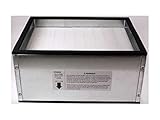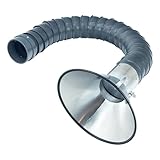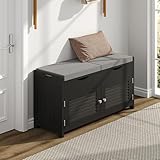In today’s world of electronics repair, soldering, 3D printing, laser engraving, and laboratory work, air quality isn’t just comfort—it’s safety.
Fume smoke extractors are the first line of defense against hazardous fumes, particulates, and harmful gases, capturing contaminants at their source before they can spread through workshops or labs.
1. What is a Fume Smoke Extractor? Basics & Why Accessories Matter
A fume smoke extractor is a local exhaust ventilation device designed to capture, filter, and remove hazardous particles, vapors, or gases at the source. In contexts like electronics repair, laser cutting, 3D printing, metalworking, or science classrooms, they’re essential for:
- Removing lead, flux, and solvent fumes from soldering
- Filtering out microplastics, particulates, and chemical vapors from 3D printing
- Capturing corrosive fumes from chemical handling or etching
- Containing smoke and dust from laser cutting or engraving
Accessories are what adapt generic fume extractors to these diverse roles—improving efficiency and convenience, customizing the system’s capture range, and protecting both users and the device itself.
2. Essential Accessories for Fume Extractors: What They Are and Why You Need Them
a. Filters and Pre-Filters
- HEPA Filters: Trap >99.97% of small particulate matter, including dust, smoke, and allergens.
- Activated Carbon Filters: Adsorb volatile organic compounds, odors, and chemical gases.
- Pre-Filters: First line—catches large particulates, extends main filter life.
b. Extraction Arms and Hoods
- Flexible, Articulated Arms: Direct extraction exactly where needed, crucial for soldering, lab work, or laser marking.
- Hoods: Funnels, domes, or slot hoods to maximize intake efficiency for different tools and workpiece sizes.
c. Ducting and Mounting Hardware
- Flexible Ducting: Extends extraction reach, routes fumes to the extractor or exhaust point.
- Adapters, Clamps, Brackets: Mount extractors overhead, on benches, carts, or walls; secure arms in place.
d. Remote Controls, Switches, and Sensors
- Wireless Remotes: For extractors installed out of reach or in busy classrooms.
- Automatic Flow/Presence Sensors: Turn extraction on/off with machine or occupancy, saving energy.
e. Noise Suppression and Silencer Kits
- Inline Mufflers/Silencers: Reduce operation noise in quiet workspaces or classrooms.
f. Filter Status and Maintenance Kits
- Filter Change Indicators: Warn when airflow drops or filter is clogged.
- Replacement Filter and Pre-Filter Packs: Essential for service schedule adherence.
3. Top 12 Best Fume Smoke Extractor Accessories (2025 Reviews and Applications)
These are top categories and representative products—match to your specific fume extractor brand/model or size requirements. Always verify compatibility before purchasing!
1. BOFA Pre-Filter Pads & HEPA Cartridges
- Fits: BOFA, Hakko, and similar compact solder fume extractors
- Description: Multi-layer pre-filters (G4 or F7) paired with high-grade HEPA (H13+) main filters
- Why It’s Great: Pre-filters capture large particles, extending expensive HEPA life—essential for high-use soldering stations and strong airflow.
2. Activated Carbon Filter Packs (Universal and Brand-Specific)
- Fits: Hakko FA-430, KOTTO, Weller ZeroSmog, custom setups
- Description: Deep bed carbon filters adsorb solvent fumes, VOCs, flux smells
- Why It’s Great: No more chemical odors; must-have for 3D printing (ABS, resin) and solvent soldering.
3. Flexible Extraction Arms (ESD-Safe, Metal or Polyurethane)
- Fits: Diameters 50–75mm common (BOFA, Fumex, Kohstar, and many others)
- Description: Easily position and hold airflow directly over work, adjustable length/pose
- Why It’s Great: Precise hood placement disables “fume drift”—critical for proper containment.
4. Extraction Funnel Hoods (Various Sizes)
- Fits: Standard arms/ducts
- Description: Enlarged intake “funnels” for capturing smoke plumes from wide or multiple sources
- Why It’s Great: Ideal for laser engraving, solder baths, or setups where many small sources need one extractor.
5. Slot Hoods and Bench-Top Cabinets
- Fits: Electronics benches, chemistry workstations
- Description: Compact, linear slot hoods or enclosed mini-cabinets to contain fine particulates/chemicals.
- Why It’s Great: Keep fumes from escaping on busy benches, especially in shared spaces.
4. How to Choose the Right Accessories for Your Application
A. Soldering, PCB Rework, and Electronics
- Priorities: ESD-safe articulating arms, fine particulate HEPA, carbon for flux fumes.
- Must-have: Pre-filter pads (for solder splatter), small funnel or slot hoods, easy-clean ducting.
B. Laser Engraving/Cutting
- Priorities: Large-area hoods or slot inlets, deep carbon filtration for acrylic/ABS, HEPA for fine chars.
- Must-have: Integrated airflow sensors, bench mounting clamps.
C. 3D Printing (FDM/Resin)
- Priorities: Carbon/HEPA for VOCs/microplastics.
- Must-have: Flexible ducts (as printer heads move), enclosure hoods.
D. Chemical Labs/School Science
- Priorities: Full containment (benchtop cabinet), acid vapor-rated filters, easy certification of airflow.
- Must-have: Alarmed filter status, remote on/off.
E. Industrial Soldering/Repair/Production
- Priorities: High-CFM arms, multiple workstation feeding, industrial carbon/HEPA, mufflers for noise.
- Must-have: Modular ducts, centralized filter monitoring.
5. Installation and Maintenance Tips
- Correct Positioning: Place arms/hoods as close as possible (2–4 inches/5–10cm) above fume source.
- No Blocked Airflow: Avoid crushed or kinked ducting; gentle bends, not sharp corners.
- Change Pre-Filters: Every 1–4 weeks depending on use and visible debris; extends expensive filter lifespan.
- HEPA/Carbon Maintenance: Change every 6–12 months (consult manufacturer), sooner with heavy use or drop in airflow.
- Seal Joints/Tighten Clamps: Prevents fume leaks and loss of extraction pressure.
- Monitor Indicators: If your system has a pressure drop or airflow gauge, heed filter change warnings.
6. Safety, Compliance, and Indoor Air Quality Considerations
- Legal Standards: Ensure compliance with local occupational safety laws (OSHA, EPA, HSE UK, etc.).
- Fire Safety: Don’t extract explosive or burning materials unless extractor is rated for such.
- ESD Safety: For electronics work, use ESD-safe arms/hoses/clamps to avoid shocking boards.
- Exhaust: If venting outside, check for appropriate filters/permits to avoid environmental hazards.
7. Accessory Buying Guide: Frequently Asked Questions
Q: Can I use “generic” filters or accessories?
A: Sometimes—check size and compatibility. Beware of cheap, thin carbon mats marked as “HEPA.” Use genuine or proven third-party equivalents.
Q: How often should I replace filters?
A: Replace pre-filters monthly, carbon 3–6 months, HEPA 6–12 months, or if you notice airflow drops, new odors, or alarms.
Q: Are longer arms or ducts less effective?
A: Longer means more resistance, so airflow drops—prefer shorter runs or higher-power extractors for distant sources.
Q: Why is my extractor still noisy after adding a muffler?
A: Noise can also be from the motor or turbulent airflow—ensure silencer is properly installed and not undersized.
Q: Can accessories from other brands fit my extractor?
A: Yes, if size and fitting match (50/75/100mm common). Always check for ESD, airflow, and filter specs.
8. Final Recommendations
The best fume smoke extractor accessories turn a basic setup into a flexible, high-performance, low-maintenance air quality solution.
Whether you are in a school, industrial plant, high-tech repair shop, or home lab, your top priorities should be:
- Regular replacement of filters and pre-filters—protects both the user and the extractor itself.
- ESD-safe, articulated arms/hoods for targeted capture.
- Alarmed filter indicators to ensure you never work unprotected.
- Mufflers for noise reduction in quiet environments.
- Proper mounting, ducting, and bench clamps for safety and ease of use.
Among top brands, genuine BOFA, Hakko, Fumex, and KOTTO accessories lead in reliability and innovation, but universal kits (when chosen wisely) can also deliver pro performance.
Yet, even the best smoke extractor is only as good as its setup. The right accessories—ranging from filters and ducts to arms, pre-filters, hoods, maintenance kits, and mounting solutions—can optimize extraction efficiency, extend system life, reduce costs, and adapt your setup to evolving needs.
This guide reviews 2025’s best fume extractor accessories, the principles behind their selection and installation, and how to tailor any smoke extraction system for maximum safety, performance, and convenience—no matter your environment.
Invest in the right accessories and maintain them well—you’ll preserve your health, your workspace, and your peace of mind.





